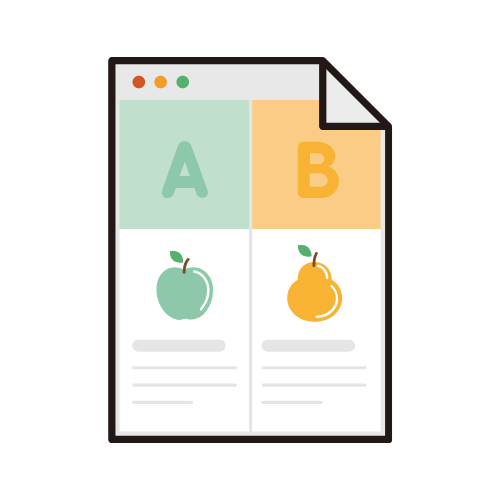A/B testing is a powerful tool for product managers to evaluate the impact of new features on user behavior. By splitting traffic into a control group and one or more variants, it allows you to measure the impact of changes on behavioral metrics such as engagement, conversion rates, and retention. In this post, we’ll explore the key concepts of A/B testing, including how to design effective experiments, analyze the results, and make data-driven decisions about your product.
Contents
This series of posts focuses on the crucial concepts of product management, including product strategy, roadmap creation, market analysis, and UX design. The goal is to give a comprehensive overview of the key principles and practices all product managers should understand.
🔍 If you want to read the concise version of this post then just read the text written in bold.
A/B testing, also known as split testing or experimentation, is a method of comparing two versions of a product feature or design to determine which one performs better. This technique allows product managers to make data-driven decisions about their product by measuring the impact of changes on key metrics such as engagement, conversion rates, and retention.
A/B testing for product managers
A/B testing can be extremely helpful for product managers in a number of ways. Firstly, it allows them to validate their assumptions about how users will interact with a product, which can help to guide product development decisions. Additionally, A/B testing enables product managers to test different features or designs to see which ones will drive the most engagement and conversion, which can help to optimize product performance.
| Objective | Assess the impact of new features on user behavior |
| Methodology | Divide users into a control group and one or more variant groups |
| Key Metrics | Engagement, conversion rates, and retention |
| Experiment Design | Create an experiment that modifies one variable at a time to test the effect on a specific metric |
| Results Analysis | Examine the data collected to understand the impact of the changes |
| Data-driven Decisions | Use the information obtained to make informed decisions about the product |
A/B testing into action
Here are some practical examples of different contexts where you can use A/B testing:
| Experiment | Variable to Test | Test Goal |
|---|---|---|
| Landing page title test | Different titles | Identify the title that generates the most sign-ups |
| Pricing strategy test | Various pricing strategies | Find the pricing strategy that maximizes product subscriptions |
| Call-to-action button test | Various call-to-action buttons | Discover the call-to-action button that yields the most conversions |
| Mobile app layout test | Different app layouts | Determine the layout most preferred by users |
| Email subject line test | Various email subject lines | Determine the subject line that results in the highest open rate |
| Website color scheme test | Different color schemes | Find the color scheme that leads to the longest session duration |
| Product description test | Different product descriptions | Identify the product description that leads to the highest purchase rate |
| Test of checkout process | Different checkout process designs | Find the design that reduces cart abandonment rate |
An example of a technical A/B test in the context of a website
Let’s suppose we have a website that sells clothing and we want to determine which call-to-action (CTA) button color results in more sales.
| Phase | Description | Specific Example |
|---|---|---|
| Hypothesis Definition | Establish a hypothesis to test | The hypothesis is that a red CTA button generates more sales than a green CTA button |
| Experiment Design | Divide website visitors into groups | Visitors are split into two groups: Group A sees a green CTA button, Group B sees a red CTA button |
| Experiment Implementation | Use tools to implement the A/B test | Use Google Analytics or Optimizely to track the number of sales for each group |
| Results Analysis | Use statistical methods to analyze the collected data | If the difference between the conversion rates of the two groups is statistically significant, the red CTA button has generated more sales |
| Decision Making | Make a decision based on the results of the test | If the A/B test shows that the red CTA button generates more sales, choose to use this color on the website |
Note: This is just one example of an A/B test and the steps may vary depending on the specific use case. The important thing is to use a rigorous and systematic approach to test and validate your hypotheses.
A short history of A/B testing
A/B testing is a method of comparing two versions of a product or marketing campaign to determine which is more effective. It was first used in the early 20th century to test different versions of advertisements and has since evolved into a common practice in fields such as marketing, software development, and web design. The rise of digital marketing in the 1990s and 2000s popularized A/B testing, and today it is an essential tool for optimizing user experience and increasing conversions.
In conclusion, A/B testing is an essential tool for product managers to evaluate the impact of new features on user behavior. By dividing traffic into a control group and one or more variants, it allows you to measure the impact of changes on behavioral metrics such as engagement, conversion rates, and retention. With A/B testing, product managers can validate their assumptions, test different features or designs, and make data-driven decisions about their product.
Key Takeaways
| Key Takeaways | Description |
|---|---|
| Understanding A/B Testing | A/B testing is an experimental approach used to compare two versions of a webpage, app, or other product to determine which performs better. |
| Advantages of A/B Testing | A/B testing allows businesses to make data-driven decisions, minimizing risks associated with implementing new features and maximizing the potential for user engagement and conversion rates. |
| A/B Testing in practice | The process involves presenting a control group with the original version (A) and an experimental group with the modified version (B), then comparing the performance of both. |
| Limitations of A/B Testing | Despite its strengths, A/B testing has some limitations. For example, it requires a sufficient sample size to yield statistically significant results, and it cannot capture the complexity of user behavior or the impact of external factors. |
In conclusion, A/B testing serves as a powerful tool in assessing the impact of new features by enabling data-driven decisions, but it must be used with an understanding of its potential limitations and the complexities of real-world user behavior.

